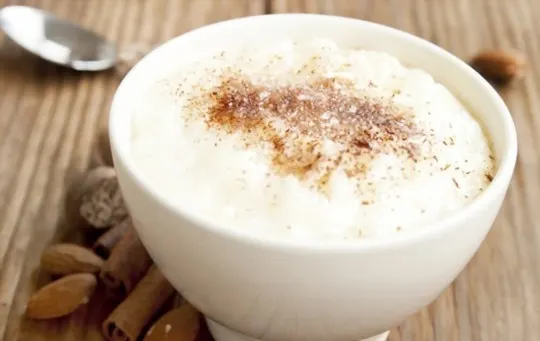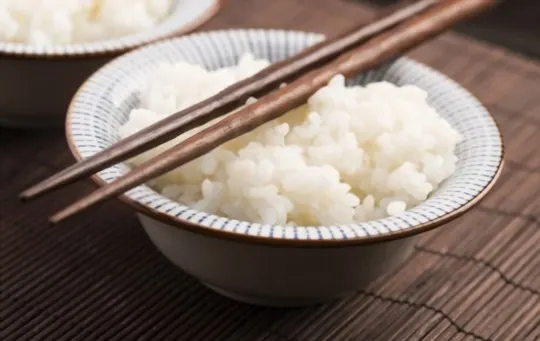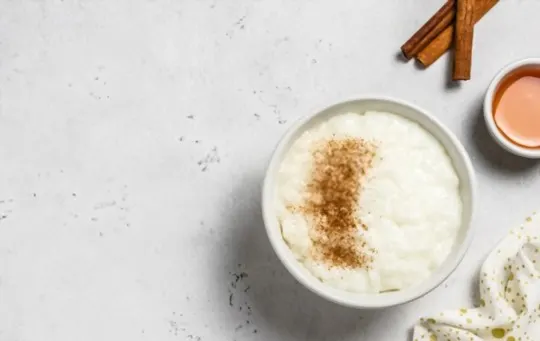Rice. It’s not just a side dish; it’s the main event in many meals. Sweet Rice and Sushi Rice stand out. They’re like the cool cousins in the rice family.
We’ve all been there, ready to whip up something in the kitchen. You reach for rice, and then pause. Sweet or Sushi? The labels stare back, silent.
We’ve made the mistakes so you don’t have to. Swapped one for the other and ended up with a culinary oops.
Here’s the scoop on how these two differ. It’s all in the details, folks.
What is Sweet Rice?

Sweet rice, also known as glutinous rice or sticky rice, is a type of short-grain rice that has higher amounts of starch than regular rice.
The name may be misleading as it does not actually contain gluten but gets its sticky texture from the high amount of amylopectin in the grains.
Sweet rice is commonly used in Asian cuisine, especially for desserts and snacks.
When cooked, sweet rice has a distinct chewy and slightly sticky texture that makes it perfect for dishes like sushi rolls and mochi.
It can also be used as a flour alternative in baking recipes for items like bread or cakes.
It’s essential to note that sweet rice should not be confused with sushi or Calrose rice.
They differ significantly in taste, texture, and culinary uses.
What is Sushi Rice?

Sushi rice is a short-grain variety of rice native to Japan and used for making sushi rolls.
The unique characteristic of sushi rice is its sticky texture, which helps the ingredients bind together when making rolls.
Sushi rice is cooked with vinegar, sugar, salt, and water to give it a tangy flavor that complements the fillings in the sushi rolls.
One other significant aspect of sushi rice is its size; however, it may seem small.
It plays a crucial role in sushi-making as they can be formed into different shapes like nigiri or molded into triangle shapes.
Additionally, Sushi Rice should be warm when making sushi to avoid breaking the grains’ shape while shaping and making rolls.
Therefore, temperature control during and after cooking is essential.
Differences Between Sweet Rice and Sushi Rice

Sweet rice and sushi rice have subtle differences that significantly affect their taste, texture and usage.
Sweet rice is a glutinous variety that is softer, shorter and stickier than sushi rice.
Sushi rice has more firmness and elongation in their grains, making it the perfect choice for sushi rolls.
Grain Variety
Differentiation between rice varieties affects the flavor, texture, and usage of the rice.
When it comes to ‘Grain Variety’, three of the most popular types are short-grain, medium-grain, and long-grain.
Short-grain varieties tend to be more sticky and are better suited for dishes like sushi and risotto due to their absorbent properties.
Medium-grain varieties are less sticky than short-grained ones yet have similar absorption properties, making them ideal for meals that require a bit of stickiness.
Long grain varieties do not stick together as much as short or medium grain kinds, but they provide lightness and fluffiness in meals such as pilafs and biryanis.
It is imperative to know which variety suits a dish best because using the incorrect type can alter the taste completely.
Texture and Stickiness
The unique texture and stickiness of different types of rice can greatly impact the end result of your dish.
In particular, when it comes to cooking sushi and sweet rice, the texture and stickiness are essential elements for making the perfect dish.
While both types of rice may appear similar at first glance, they have significant differences that make them better suited for specific dishes.
Sushi rice has a distinct firm texture with a sticky consistency that allows it to be easily molded into sushi rolls or individual pieces.
The stickiness also helps to keep the ingredients in place while eating.
On the other hand, sweet rice has a softer texture and a more cohesive consistency that makes it ideal for desserts like mochi or sticky rice pudding.
When cooked properly, sushi rice should retain its distinctive structure, while sweet rice will become tender and slightly chewy in texture due to its higher starch content.
Additionally, sushi rice is usually seasoned with vinegar, salt, and sugar after cooking to add an extra layer of flavor.
Understanding the difference between these two types of rice is essential for creating authentic dishes and achieving desired outcomes.
By carefully selecting which type of rice to use based on their unique characteristics, you can elevate your culinary creations and impress your guests with restaurant-quality cuisine.
Cooking Method
To create authentic and delicious rice dishes, the cooking method used is crucial.
The choice of rice will determine the method used to cook it.
The right approach will enhance the characteristics and taste of the final dish while preserving the texture of the rice.
For sweet rice, steaming is an ideal cooking method since it showcases its stickiness and sweetness.
The delicate flavor profile of sweet rice is better retained through steaming, which ensures that moisture stays within the grains, leading to a fluffy texture.
A slight variation to this technique is boiling where salt can be added to adjust flavor elements.
Sushi rice calls for a more complex cooking technique: soaking, rinsing several times before steam infusion and seasoning.
This process brings out a specific delicacy that no other cooking method would manage without softening or breaking sushi’s signature texture elements.
Sushi is served at room temperature; therefore, the emphasis on seasoning enhances its individualistic quality more than other varieties.
Flavor and Taste
The subtle variations in the flavors of sweet rice and sushi rice may not be noticeable by some, but for aficionados, they make all the difference.
Sweet rice has a distinctively sweeter taste than sushi rice due to its higher sugar content, while sushi rice has a more acidic and mild-tasting profile which is an ideal match for raw fish.
The overall flavor of both types of rice is delicate yet flavorful, and it only takes small adjustments in the cooking process and seasoning to bring out their unique tastes.
Similarities Between Sweet Rice and Sushi Rice

Sweet Rice and Sushi Rice share several characteristics, making them both attractive to those who love rice dishes.
These two types of rice are short-grained and have a sticky texture when cooked.
They are also high in starch content, enabling them to retain their shape and not get mushy quickly.
Lastly, sweet rice and sushi rice require a similar amount of water to cook to achieve the desired result.
In terms of taste, Sweet Rice and Sushi Rice differ significantly.
Sweet Rice possesses a subtle sweetness that works ideally for desserts or as an accompaniment to spicy dishes; on the other hand, Sushi Rice is mild-tasting and primarily used as the base for sushi rolls.
Unlike the previously discussed similarities, Sushi Rice has considerably less moisture than sweet rice when prepared correctly.
Moisture controls how sticky your cooked rice will be; reducing the moisture level transforms your sushi into perfect bites without adding unwanted stickiness.
Culinary Uses of Sweet Rice and Sushi Rice
Sweet Rice and Sushi Rice are two unique varieties of rice that differ in their culinary uses.
The former is commonly used in making desserts, while the latter is a primary ingredient in preparing sushi dishes.
Sushi rice is short-grain and sticky, while sweet rice has a slightly longer grain but becomes stickier when cooked.
Moreover, sushi rice has a distinct vinegar seasoning that gives it a tangy taste, whereas sweet rice has a subtle sweetness that makes it ideal for creating traditional Asian desserts like mochi and pudding.
It’s essential to note that despite their names, both types of rice can be used interchangeably in certain recipes.
For example, sweet rice can be used to make sushi rolls with unique flavors such as fruits or coconut milk.
Sushi rice can also be used to make different snack items like Onigiri and Rice crackers.
Which Rice to Use for Different Recipes?
Different rice types complement different dishes.
Making the correct choice can be a herculean task, but it’s essential to get that perfect flavor and texture that you are looking for.
Each dish calls for a unique grain size, shape, starch content, and aroma.
So which rice should you use? Let’s find out.
- For sushi lovers out there, sushi rice is your go-to choice. This Japanese rice variety is sticky with just the right amount of moisture content for perfect bite-sized Sushi pieces.
- On the other hand, if you’re making puddings or desserts, sweet rice is the appropriate type because it has a starchy and moist texture needed to achieve optimal creaminess.
- However, Basmati and Jasmine varieties work best if you’re preparing biryani and stir-fry meals. They have grains that separate easily, which ensures that flavors are distributed equally in your dishes.
- In contrast, long-grain white rice is excellent for making fried-rice or pilaf because they don’t clump together during cooking.
In summary, making the correct choice depends on factors such as how much water your recipe requires and what dish you plan on making: whether it is Sushi or Pudding; stir-fry meal or Biryani.
Just remember to stick with basic descriptions of each type of rice type when reading recipes and ingredient lists hinting on which one would work best for your meal.
Conclusion
Different types of rice are used in various cuisines worldwide, and among them, sweet rice and sushi rice are quite common.
Though often confused, they are not the same.
Sweet rice is stickier and more glutinous compared to sushi rice, which is primarily cultivated in Japan.
Both of them differ in their texture, taste, shape, and method of preparation.
To understand these variations better, let us dive into some specifics.
While both the types might appear somewhat similar initially due to their texture and cooking processes used for them; they can clearly differentiate based on the end results – one being soft & sweet while others being gummy & slightly dry after cooking.
Hence understanding these differences well allows you to use the right type of rice depending upon your preference and dish requirement without any confusion or mishap occurring.

Leave a comment